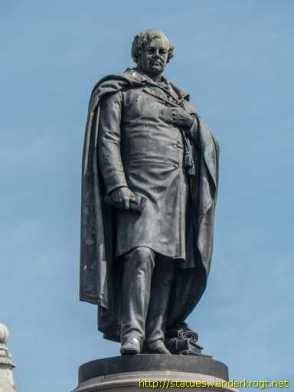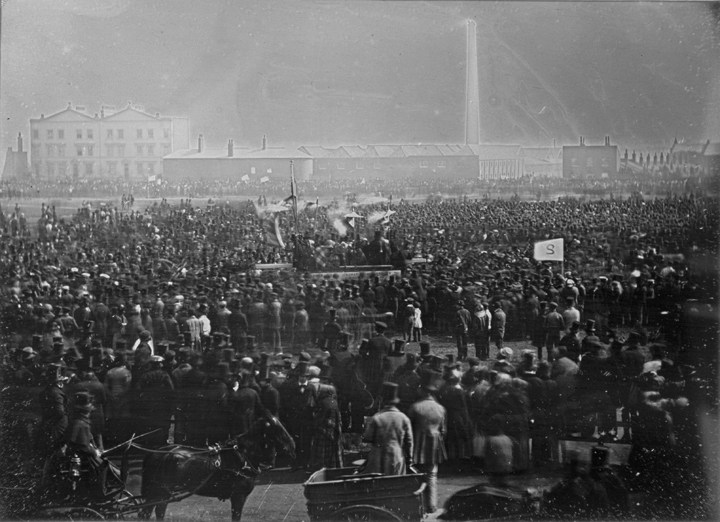The spring and summer of 1848 saw failed rebellions in England and Ireland, both led by Irish men. And the Irish tricoleur, a symbol of peace, made its first appearance. In May, 170 years ago this month, the leaders of the Irish rebellion were sentenced to transportation.

One of Daniel O’Connell’s proteges*, Cork land-owner and lawyer Feargus O’Connor, was elected MP for Cork in 1832. Shortly afterwards he fell out with O’Connell and in 1835 lost his seat in Parliament. He then embarked on a campaign for political reform in England. Founding a newspaper, The Northern Star, he was joined by William Lovett and others.
Their People’s Charter was published – in May 1838 – as a draft parliamentary bill. It contained six points: manhood suffrage; the ballot; abolition of property qualifications for MPs; payment of MPs; equal electoral districts; and annual elections. Thousands of working people had rallied together on the basis of this charter, and hundreds of them had gone to prison for their beliefs.
In the 1847 general election O’Connor was elected MP for Nottingham. By the spring of 1848, inspired by events elsewhere in Europe, the movement was ready to make it’s mark. A petition had been raised, signed, it was claimed, by over 5 million people. A meeting was arranged for April 10th on Kennington Common just across the Thames from Parliament.

The government were well prepared with 170,000 citizens signed up as special constabulary and army units stationed at the entrance to each of the bridges and protecting ministries and ministers’ homes. Despite an expected turn-out of 200,000, a mere 20,000 congregated.
When it began to rain heavily, most quickly disbursed. O’Connor and his henchmen crossed Westminster Bridge in horse drawn carriages and presented his petition which was found to contain only 2 million names, many of them forged, invented and duplicated. The name of no less a figure than the Duke of Wellington appeared 17 times.
Meanwhile, 1848 was a year of turmoil across Europe, with revolutions taking place in France, Germany, Austria, Denmark and the Netherlands. In February the last vestige of the French Royal family fled France never to return. Inspired by this, a Young Ireland delegation led by William Smith O’Brien and Thomas Francis Meagher, went, in April, to Paris to meet with representatives of the new French Republic.
Symbol of Peace
Whilst there, they were given a flag modeled on the French Tricoleur on which the three colours that were represented were green, the colour of Catholic nationalism, orange, the colour of Protestant unionism, separated by white to signify the desire for peace between the two traditions. Since 1922 this has been the national flag of the Irish Republic.

For leaders of the Confederation, the fact that the 1848 French revolution had been relatively bloodless was an inspiration and they hoped to be able to mobilise people from all strata of Irish society in a bid to return government of the Irish to Ireland. One of the ways they set out to achieve this was via a newspaper called The Nation. However, the authorities quickly took action to nip the Confederation’s activities in the bud.
The attempted English revolution descended into farce, but the authorities were alerted to the possibility of something similar occurring in Ireland. Three of the leaders of the Irish Confederation were arrested and charged with treason. In May, having been found guilty, they were sentenced to 14 years transportation. Before this punishment could be put into effect, its imposition provided the impetus for a recruitment campaign leading to a potential rebellion.
On 29th July O’Brien led the siege of a cottage in Ballingarry, County Tipperary, in which some members of the constabulary had taken refuge. One of his men was killed by a random shot fired from within the cottage and O’Brien led his men away. He was arrested shortly afterwards at Thurles railway station.
One of the men who had accompanied O’Brien to Paris in April, Richard O’Gorman, was organiser for the rebellion in Limerick. A few days after the Ballngarry incident, a group of about 200 men, supposedly acting on behalf of O’Gorman, held up the Limerick-Tralee mail coach at Abbeyfeale. They confiscated the arms and official dispatches it contained but returned private mail to the postmaster. They considered mounting a siege of the town but, when they heard the news from Tipperary decided to call a halt.
O’Gorman disappeared. Two different speculative accounts of his escape from arrest, include the possibility that he traveled via Kilrush. Indeed, two men were arrested and accused of transporting him aboard a steamer bound for the town. A less likely tale has him aboard another Kilrush bound steamer disguised as a woman.
Whatever the fate of O’Gorman and the other conspirators, there can be no doubt that the rebellion, if not quite as farcical as that in England, nevertheless fizzled out for lack of support. It did nothing to help relieve the suffering of those who had neither food nor the means to acquire it except by sacrificing what few possessions they had. On the contrary, it served to harden public opinion in England where the Irish were already being viewed as ungrateful.
This post contains extracts from chapters 11 and 12 of A Purgatory of Misery.
*For those who may be unfamiliar with the man who gave his name to Ireland’s central thoroughfare and whose statue stands at its southern end, Daniel O’Connell was the leader of a movement seeking repeal of the Act of Union which bound Ireland to the United Kingdom.

Frank, I now have a copy of your book but have not yet had a chance to read it.
LikeLiked by 1 person
Thank you, Rosaliene
LikeLiked by 1 person
Love history and enjoy historical fiction more. Thanks for the post.
LikeLiked by 2 people
Nice bit of history, Frank – my knowledge of Irish history is pretty patchy and I had no idea of the noble inspiration behind the Irish tricolour. As for the Chartists – it’s amazing their aims took so long to be achieved – though I don’t believe we have equal electoral districts yet in Britain and annual elections strike me as impractical and unduly expensive. Nothing about women getting the vote, either!
LikeLiked by 2 people
Thanks for following my blog; you are very kind.
LikeLiked by 1 person
Thank you very much.
LikeLiked by 1 person